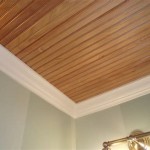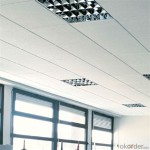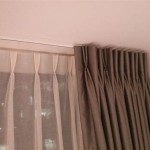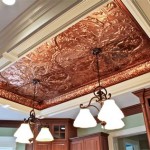Enhancing Living Room Aesthetics: Drop Ceiling Design Ideas
The living room, often considered the heart of a home, serves as a central space for relaxation, entertainment, and social interaction. Its design plays a crucial role in establishing the overall ambiance and aesthetic appeal of the residence. While elements such as furniture, wall decor, and flooring are significant, the ceiling often presents an overlooked opportunity for enhancing the room's visual impact. Drop ceilings, also known as suspended ceilings or false ceilings, offer a versatile solution for improving the functionality and appearance of a living room. These ceilings are installed below the existing structural ceiling, creating a cavity that can accommodate various design enhancements and practical benefits.
This article will explore various drop ceiling design ideas suitable for living rooms, focusing on their aesthetic contributions, functional advantages, and installation considerations. The aim is to provide comprehensive information to assist homeowners and designers in making informed decisions about incorporating drop ceilings into their living room design plans.
Acoustic Enhancement and Soundproofing
One of the primary benefits of drop ceilings is their ability to improve the acoustic properties of a room. Living rooms, frequently used for entertainment or conversation, can suffer from excessive echo and noise reverberation, particularly in rooms with hard surfaces like tile or hardwood floors. Drop ceilings constructed with acoustic tiles or panels can significantly reduce these issues. These materials are designed to absorb sound waves, minimizing reflection and creating a more comfortable and enjoyable auditory environment.
Acoustic tiles are typically made from mineral fiber, fiberglass, or recycled materials treated to enhance sound absorption. The Noise Reduction Coefficient (NRC) is a key metric used to evaluate the sound-absorbing performance of drop ceiling tiles. A higher NRC value indicates greater sound absorption. When selecting acoustic tiles for a living room drop ceiling, it is important to consider the desired level of soundproofing and the existing noise levels in the surrounding environment. For living rooms near busy streets or with thin walls, higher NRC-rated tiles may be preferred.
In addition to acoustic performance, the design of the acoustic tiles can also be adapted to suit the aesthetic preferences of the homeowner. Acoustic tiles are available in a wide variety of textures, patterns, and colors, allowing for customization to complement the overall decor of the living room. Some manufacturers even offer custom printing options, enabling homeowners to incorporate unique designs or artwork into their drop ceiling.
Furthermore, the cavity created by the drop ceiling can be used to install soundproofing materials, such as fiberglass insulation or sound-dampening mats. These materials can further enhance the soundproofing capabilities of the drop ceiling, creating a quieter and more private living space. This is particularly useful in apartments or multi-dwelling units where noise transmission between floors can be a concern.
Concealing Wiring and Infrastructure
Another significant advantage of drop ceilings is their ability to conceal unsightly wiring, ductwork, and plumbing pipes. Modern homes often have a complex network of electrical wiring, HVAC systems, and plumbing that can detract from the aesthetic appeal of a living room. Rather than leaving these elements exposed or attempting to conceal them with bulky drywall boxes, a drop ceiling provides a clean and seamless solution for hiding them from view.
By creating a cavity between the structural ceiling and the drop ceiling, wiring and pipes can be neatly organized and concealed. This eliminates the need for unsightly surface-mounted conduits and exposed ductwork, resulting in a cleaner and more streamlined appearance. This is particularly beneficial in older homes where the original wiring or plumbing may not be aesthetically pleasing.
Furthermore, the drop ceiling allows for easy access to these hidden utilities for maintenance and repairs. Unlike a solid drywall ceiling, drop ceiling panels can be easily removed and replaced, providing convenient access to the wiring and pipes above. This simplifies future maintenance tasks and reduces the need for costly and disruptive repairs. The ability to access utilities without damaging the ceiling is a significant advantage for long-term maintenance and renovation projects.
In addition to concealing wiring and pipes, drop ceilings can also be used to incorporate recessed lighting fixtures. Recessed lighting provides a clean, modern look and can significantly enhance the ambiance of a living room. The drop ceiling cavity provides ample space for installing recessed lighting cans and associated wiring, creating a seamless and integrated lighting design. The combination of concealed utilities and integrated lighting contributes to a more polished and refined living room aesthetic.
Design Flexibility and Aesthetics
Beyond their functional benefits, drop ceilings offer considerable design flexibility and can significantly enhance the aesthetic appeal of a living room. They are available in a wide variety of materials, textures, colors, and patterns, allowing for customization to suit virtually any design style. From classic and traditional to modern and contemporary, drop ceilings can be tailored to complement the overall decor of the living room.
One popular design option is the use of decorative tiles or panels. These tiles can feature intricate patterns, embossed designs, or even custom artwork. Decorative tiles can add visual interest and texture to the ceiling, transforming it from a plain surface into a focal point. They can be used to create a variety of effects, from subtle and understated elegance to bold and dramatic flair.
Another design trend is the integration of lighting features into the drop ceiling. In addition to recessed lighting, drop ceilings can accommodate other types of lighting fixtures, such as pendant lights, chandeliers, or LED strip lighting. These lighting features can be used to create a variety of moods and effects, from ambient lighting to task lighting. LED strip lighting, in particular, can be used to create a subtle and elegant glow around the perimeter of the ceiling, adding depth and dimension to the room.
Furthermore, drop ceilings can be used to create different ceiling heights and shapes. By varying the height of the drop ceiling in different areas of the room, it is possible to create the illusion of higher ceilings or to define different zones within the living room. For example, a higher ceiling above the seating area can create a sense of spaciousness, while a lower ceiling above the dining area can create a more intimate and cozy atmosphere.
The material of the drop ceiling can also significantly impact the overall aesthetic. Mineral fiber tiles offer a classic and timeless look, while metal tiles provide a more modern and industrial feel. Wood panels can add warmth and texture to the room, while fabric-covered panels can create a soft and luxurious ambiance. The choice of material should be carefully considered to ensure that it complements the existing decor and the desired aesthetic of the living room.
Ultimately, the design possibilities for drop ceilings are virtually endless. With careful planning and attention to detail, drop ceilings can be transformed from a purely functional element into a stunning and integral part of the living room design.
Beyond the points mentioned above, it's crucial to address the installation process. Installing a drop ceiling requires careful measurement and planning to ensure a level and aesthetically pleasing result. The grid system, typically made of metal, must be securely attached to the existing structural ceiling, and the tiles or panels must be properly fitted within the grid. While DIY installation is possible for experienced homeowners, professional installation is often recommended to guarantee a correct and safe outcome.
Moreover, regarding maintenance, drop ceilings are relatively easy to maintain. Regular dusting or vacuuming can keep the tiles clean and free from debris. Stains or damage can often be addressed by simply replacing the affected tile, making repairs quick and cost-effective. The accessibility provided by the drop ceiling design simplifies the process of upkeep and ensures the ceiling remains in optimal condition for years to come.
Lastly, consider the environmental impact. Selecting drop ceiling materials made from recycled content and that are themselves recyclable is a environmentally responsible choice. Several manufacturers offer sustainable options that contribute to a greener home environment. In addition, the improved insulation and soundproofing properties of a drop ceiling can potentially reduce energy consumption, further enhancing its sustainability credentials.

Drop Ceiling Design Ideas Ceilings Armstrong Residential

Best False Ceiling Design Ideas For Living Rooms In 2025 Gyproc
.jpg?strip=all)
False Ceiling Designs For Living Room

Ceiling Decor And Design Ideas By

3 Reasons Why Your Living Room Needs A False Ceiling

6 Suspended Ceiling Decors Design Ideas

6 Suspended Ceiling Decors Design Ideas

Top 30 Beautiful False Ceiling Pop Designs For Living Room Bedroom

Explore False Ceiling Profile Lights For Modern Ambiance Beautiful Homes

False Ceiling Design
Related Posts








